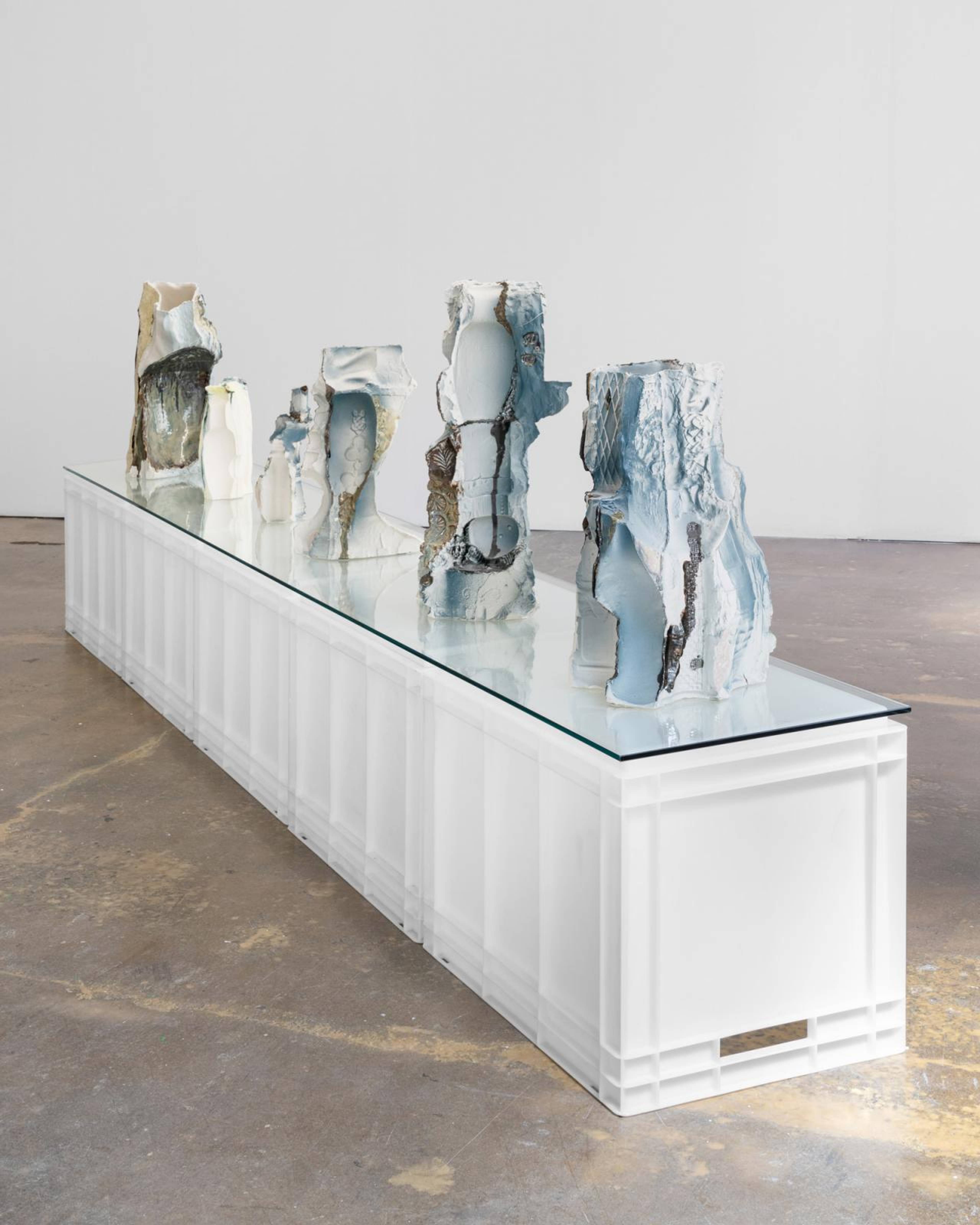The interdependence of different industries and institutions – political, social, or cultural – that can enhance the competitiveness of an overall system is what socioeconomists define as an “industrial complex.” Shaped by factors like technological advances, government policies, and consumer demand, it is ultimately a web of production, distribution, and consumption – processes of agglomeration and engineered synergy between different centers of profit for the sake of economic advantage.
Profit politics, meanwhile, is the common denominator of the creative industry as a whole. This could sound obvious, but if we look at the entire cultural economy, we see the extent to which the mechanisms of fruition, intellectualization, and exchange of cultural goods are tied to the market, and most frequently to systems and institutions of industrialization.
View of CFGNY, “Emporium,” Marsèll, Milan, 2023. Unless otherwise noted, all images courtesy: the artists Photos: Delfino Sisto Legnani
Milan, for example, is the brand of an industrialist city. More often than not, the cultural objects it produces are contextualized within an industrial framework and become commodities by nature, a residual effect of economic supremacy. Milan’s yearly design fair, the Salone del Mobile, has progressed from a specialist trade show targeting industry professionals to an intensive program of off-site events, pop-ups, showcases, and other activations produced, funded, and experienced with the ambition of passing as art. While the standard requirements to qualify as such are not at stake here, the cultural re-packaging of industrial products (here, mostly furniture) might be.
This year, between Art Week and the Salone, the New York-based art collective CFGNY (short for “Concept Foreign Garments New York”) presented “Emporium,” an exhibition curated by PIN–UP magazine publisher Felix Burrichter at Marsèll. The exhibition is thematically organized in three chapters, cardboard, porcelain, and leather, each a globally traded commodity that has shaped notions of national and cultural identity. As the city was preparing venues, locations, installations, and “spaces” for the Salone, “Emporium” counter-voiced the inherent dynamics that fuel and support such mega-events.
CFGNY, via Paolo Sarpi (IV), 2023, leather, wood, 19 x 92 x 104 cm
“We were interested in showing between Art Week and Salone exactly for the fact that these events remake the city,” say the artists. “Because remaking the city entails the creation of contact between a lot of different types of people, we were interested in making work that responded to the way in which race and ideas of an Other play out in this particular context.” CFGNY’s practice combines elements of garment-making, sculpture, architecture, and video to deliver a political reading of luxury and mass-produced goods and their aesthetic manifestations, specifically focusing on how Asian identity is labeled and commodified therein.
The ground floor of Marsèll is covered with cardboard from floor to ceiling, including structural fixtures like door handles and window frames, creating an almost two-dimensional replica of the environment. The series “128 Baxter, New York” (2023), consisting of cardboard reproductions of architectural fragments from Chinatown in New York City, comments on the material as both a goods container for the global market and a cheap, disposable building stuff.
View of CFGNY, “Emporium,” Marsèll, Milan, 2023
“via Paolo Sarpi (I)” (2023) similarly uses leather to reproduce architectural profiles and samples from the built fabric of Milan’s own Chinatown, commenting on the material's globalized luxury market in which China is forecast to account for 40% of total sales by 2025. The industry’s trans-continental exchange provides CGFNY an opportunity to articulate the tension between China’s statuses as a source of cheap garment labor for Italian brands and as the largest and fastest-growing luxury market in the world.
Throughout the show, historical and contemporary symbols of Asian commerce are recontextualized to problematize their accepted meanings. The five porcelain sculptures of “Consolidated in Relation, Slate” (2022) formally express the tension between cast and finalized works, resulting in a hybrid formation that seems engineered to fail luxury’s standards of perfection. Moreover, porcelain – a historic trade commodity originating in China – is used here to subvert the aesthetic hierarchy and notions of purity imputed to the material, resulting in an almost bootleg object.
CFGNY, Consolidated in Relation, Slate (1 Jar, 1 Tank Top, 2 Bowls, 5 Vases), 2022, glazed porcelain, 53 x 28 x 25 cm
Self-described as “vaguely Asian,” CFGNY explains “that our experience of Asian-ness may be influenced by different cultural factors, but goes beyond that to be defined by processes of racialization that homogenize a large group of people within the imaginary of the West. Asian-ness in our project then becomes amorphous and undefinable, recognizable in moments, but never able to be fully comprehended or understood, therefore the vagueness of our ‘Asian’ label.”
Furthermore, their structural collectivity becomes a tool to critique the dynamics of corporate leadership, furthering an idea of decentralization that allows multiple perspectives. “Working collectively,” says CFGNY, “is a way to acknowledge that the work we make cannot be sustained or produced without many different people supporting a shared vision.” Within the luxury-industrial complex, we are all producers, they seem to say: We participate in the process of transforming ideas and cultural symbols into luxury objects.
CFGNY, Studio Phong (Cao Trí Củ), 2023, wallpaper, dimensions variable
___
“Emporium”
Marsèll, Milan
17 Apr – 11 May 2023







